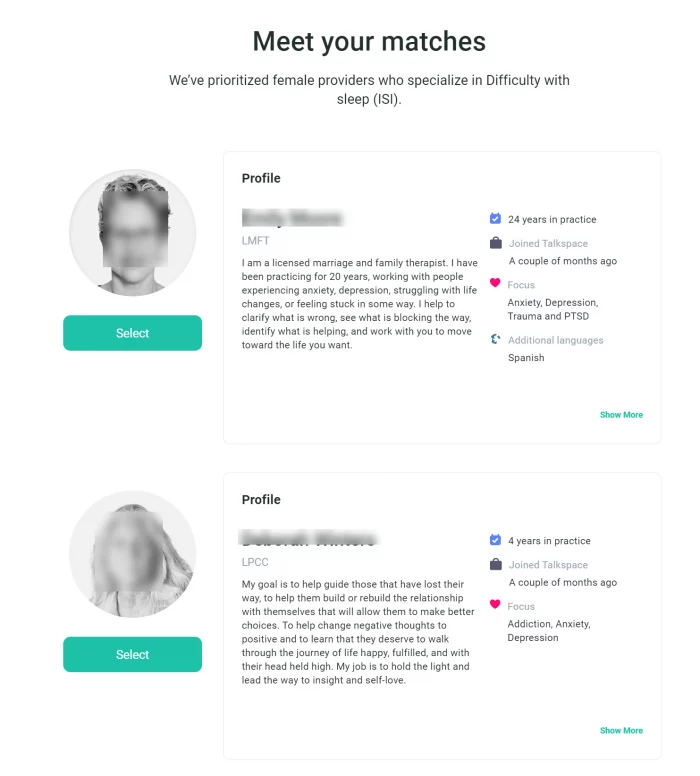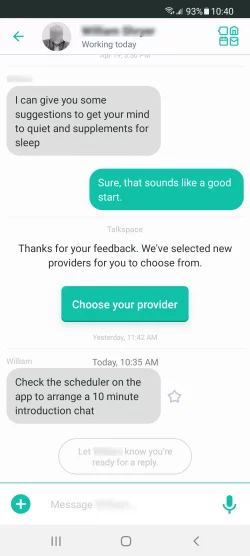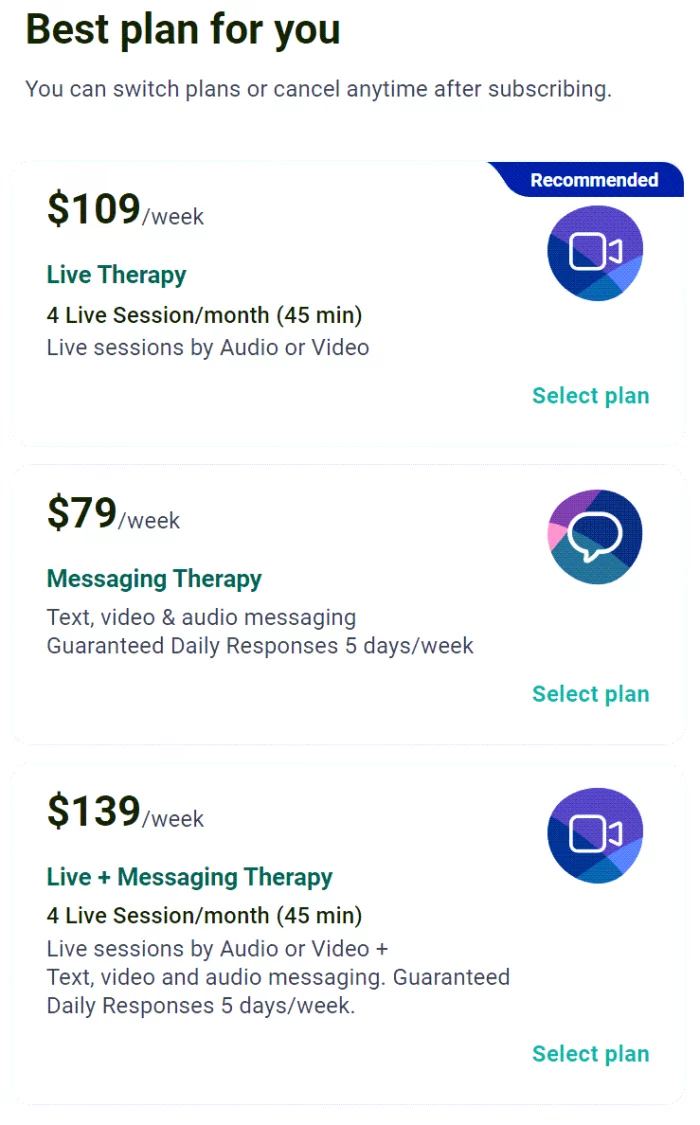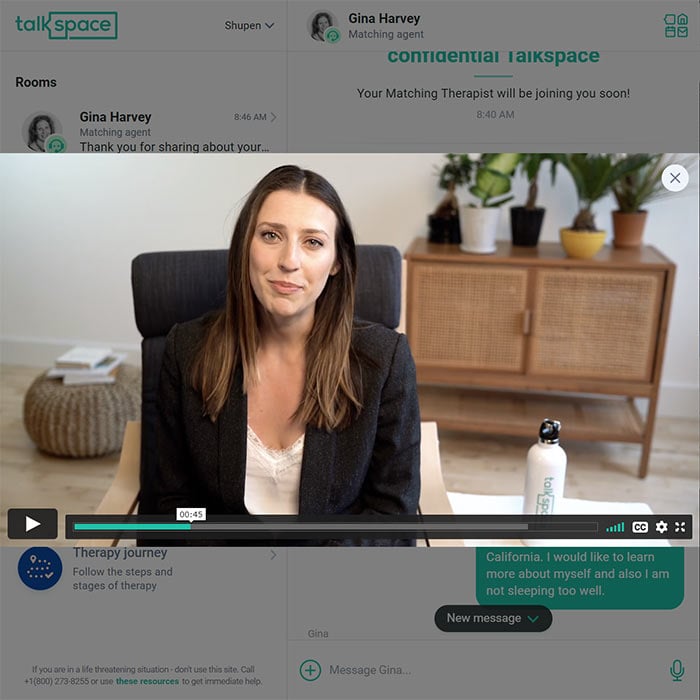Talkspace Review: Why I Left Disappointed (And I’m Not Alone)
Talkspace tries very hard to offer a good value and to make the most of the online therapy model they’ve chosen, but in my testing, they continue to fall short. It’s frustrating, because I want them to succeed and believe in what they’re trying to do. After four years of tracking them, I have learned a lot. In this article, I’ll review their pros and cons and give you my tricks for the best ways to work around their weaknesses.
October 2021 Update: My in-depth review of BetterHelp and Talkspace confirms that my impression of Talkspace’s troubles are widespread. In the article I explain why Talkspace has faced so much backlash from both end users and therapists. Read it here.
On This Page
Trouble Right Out of the Gate
None of the online therapy providers that I’ve tried do a great job matching you with a therapist, and Talkspace is no exception. Their sign-up process is a perfect example of how their website works in general. Some aspects of it are fantastic, but it ends up falling short of what it could be.
I really like that when you sign up with Talkspace, you’re messaging with a real mental health professional in real time. This is no impersonal survey. You tell them your problem and feel them sympathizing and connecting with you. At least I did, pretty much every time I signed up.
Each time, I found that the therapists or mental health workers I chatted with could answer any questions I had about Talkspace and how it worked. Sure, some of their answers were scripted, but not all of them were. They could properly answer the questions they didn’t have scripts for, too, and their responses felt that much more personal and specific to me.
So far, so good. Getting a good therapist match has been shown to be vital in improving your odds of success at therapy, and I had great hopes that the live intake process on Talkspace would make it easier for them to match me with the right therapist. I thought they would listen to what I was looking for and find it for me. Unfortunately, the actual matching process didn’t work that well. It felt impersonal and automated, as if the intake worker couldn’t apply what I was telling them about my preferences
Talkspace’s Therapist Matching Process
In the end, I was able to find a good therapist on Talkspace on my own. After I found the right person, I had a very good experience with the site. But it took a lot of effort, and I’m not sure that most people have the time or patience to keep pushing for the right match like I did.
When I signed up for Talkspace, I had a specific idea of what I was looking for. I have been in therapy several times in my life and know what I like and don’t like. I didn’t make this a mystery for the Talkspace team to figure out—I explicitly told my intake counselor what kind of approach I wanted my therapist to have.
However, the intake counselor seemed to ignore my explicit requests. The first three therapists she showed me did not have the expertise I requested. When I pointed this out to the intake counselor, she offered me one alternative who seemed to be a little closer to what I asked for, but I sensed the lack of effort on their behalf. Not wanting to be a pest, I accepted this therapist, hoping the slightly better match would be just good enough, even though my intuition told me she wasn’t a good match.
Not surprisingly, I was disappointed after my first session with her. My gut feeling was right, and as I expected, we weren’t a good match. After that first session (which took five days of my subscription time to arrange), I requested to change therapists. I was hopeful that it would be easier to find the right therapist by navigating this process on my own.
How to Change Therapists on Talkspace
The process of switching therapists on Talkspace is frustrating and not as good as it should be. When you try to change your therapist, the computer system shows you three profiles at a time to review and choose from. You can refresh to generate three new therapist profiles at a time. In theory, this should help you make a list of potential matches pretty quickly.
Unfortunately, it doesn’t quite work this way. The therapist bios are so minimal that I could not get a good feel for whether a therapist was a good match by reading them. This was true even for someone like me, a therapist who knows a lot about how therapy works. I can’t imagine that most people would be able to get the information they need to choose the right therapist through this process.
At OpenCounseling, we believe that intuition is important in choosing a therapist. Talkspace hamstrings this process so badly it makes choosing a therapist feel more like throwing darts. Choose a therapist, wait a few days for an appointment, then see if your educated guess based on limited information was correct. If it isn’t, start the process over again and throw another dart.
If you’re lucky, your dart hits the mark eventually, but I found a lot of time was wasted in this process. I hope that Talkspace is listening and finds a way to improve how choosing a therapist works on their site. Because if you do find a good match, you can have a really good experience on Talkspace. But if you don’t find a good match, the result is poor therapy. I fear that many people may end up settling for poor therapy or give up and drop out altogether. I know I felt the desire to give up many times.
My Recommended Way of Finding the RIGHT Therapist on Talkspace
Based on my multiple experiences signing up on Talkspace, I can confidently say that it’s possible to find a therapist who’s a great match on their platform. I’d even say there’s something of a science to it. I want to share my method with you so you can have the best possible experience with their platform. I recommend following these specific steps:
- Go to the Talkspace website or download and open the app.
- Start the intake process.
- Get to the point in the intake process where you are shown three different therapists to choose from.
- Try to get as much information as you can from the therapists’ profiles. You can read our article on choosing a therapist to learn more about what you should be looking for.
- If you need more information to make your decision, look for it. The descriptions on Talkspace are minimal and can make it hard to get a feel for the therapists. It can help to Google the therapists’ names to see if you can learn more about them from their official websites or from other sources.
- If the first three therapists shown to you are not a good fit, ask to see more profiles. The intake coordinator will give you one additional option at a time.
- When you find a therapist who feels like a good match, choose them.
- Start doing therapy with your new therapist. If it goes well, and you feel like it’s a good match, you’re done.
- If the match isn’t good, and you don’t feel like you’re getting much out of your time with your therapist, navigate to the menu that gives you the option to try a different therapist.
- When you request a new therapist, the site will once again show you three options at a time. Repeat the above steps with your new options, including using Google to find more information about the therapists Talkspace shows you.
- If you find someone new who seems like a good match, choose them and start therapy with them.
- Repeat this process as needed until you’ve found a good match and are having a good experience with your new therapist on Talkspace.
This may sound like a lot, because it is, but I promise you it’s worth it. I hope Talkspace listens and makes this process easier. But even if they don’t, it is possible to find a therapist who’s a good match on Talkspace, which is the key to success with their platform.

What Therapy Is Like on Talkspace
The good news is that once I did find a therapist who was a good match, I had a good experience working with her on Talkspace. The platform did a good job keeping us connected and giving me a private and confidential way of communicating with her. I could send text or audio messages whenever I liked. I enjoyed my time with her and found her empathy and insights very helpful.
In the post-COVID world, talking to my therapist this way felt completely familiar and normal. To be honest, sometimes it felt like it would be just plain backward to ever see a therapist in person again. When therapy apps do their job right, the actual app falls into the background and it’s just you and your therapist doing therapy together. With Talkspace, when things went right, they were excellent.
In addition to messaging, my Talkspace plan offered live sessions, which were key to my personal experience on the site. I and the rest of the OpenCounseling team have shared our strong opinion and warning that messaging services alone aren’t therapy. The American Psychological Association (APA) still seems to agree with our sentiment. They say, “At this point, there is no research suggesting that texting alone is an effective modality for psychotherapy.”
We’re a little less cagey about it at OpenCounseling and do have an official position on this. We think texting alone falls short of being equivalent to traditional therapy and honestly would be surprised if any evidence came out showing that it was. With that in mind, I strongly recommend you get a plan with live video sessions – the more the better.

Running into Technical Problems on Talkspace
Getting live sessions was an important part of my Talkspace experience, but it was also the part of my experience where I ran into the most technical problems.
I had a hard time when I tried to schedule a live session from the Android app or the Chrome desktop browser. Unfortunately, technical support could not resolve this issue for me (I wasted several days of my subscription time just waiting to get the technical issue unsuccessfully resolved). User reviews for Talkspace on the Google app store seem to reflect that this problem is widespread.
However, scheduling a session on the iPhone app worked perfectly for me. I pulled my old iPhone 4 from the drawer and could suddenly schedule a session. I know that in the past, Talkspace has supported iOS far more than they’ve supported Android, and it still seems the developers prioritize iOS. So, if you have the option, I recommend using the iPhone app.
Which Talkspace Plan Should I Choose?
Talkspace offers three types of plans, and each plan offers different features and has a different price. Here’s a screenshot of their current plans and prices:

Talkspace will discount your fees 10% if you subscribe for a 3 month period, or 20% if you subscribe for a 6 month period. For us this seemed like a huge gamble. We would not recommend choosing this option unless you had already settled in with a therapist and were certain you were going to see them long term.
If you want something that approaches the level of care provided by in-person therapy, you must choose Talkspace’s $109-per-week ($436-per-month) plan. This plan includes four 45-minute live video sessions per month. And while it’s true that experienced therapists in the most expensive cities sometimes charge more, your average therapist will see you for about $60 to $120 per 50-minute session. This is to say Talkspace charges similarly to seeing an in-person therapist.
They do offer a cheaper messaging plan. As I’ve already stated, I think that messaging alone doesn’t quite meet the bar to be called therapy, but it can be useful if you need help with a specific problem and don’t quite need the full level of care that therapy offers. I personally don’t recommend that you choose either of these basic plans if you have anything but the most minor of issues that you are trying to overcome.
In conclusion, it’s hard to justify Talkspace in terms of cost. That doesn’t mean you should never choose them. You may be attracted to the all-in-one platform that Talkspace offers and the ability to message your therapist when you’re in the situations where you need help the most. If you’re the sort of person who sees yourself wanting to message a lot with your therapist, Talkspace may be the right option. Ultimately, you have to think about what you want and decide if Talkspace makes sense in your particular use case.

Conclusion
In some ways, Talkspace is its own worst enemy. Time and again, it tries to be more than it is and falls short. It doesn’t do a good job matching you with the right therapist. You get your best result if you spend a lot of time researching your options and choosing your therapist manually. There are some technical issues with certain site features if you use an Android phone or a web browser instead of an iPhone. Talkspace de-emphasizes live sessions and charges a high fee for them, making it compare poorly in cost to traditional therapy.
I have spent many hours over the past four years using Talkspace and tracking its development as a company. In my research, I’ve looked through hundreds of app store reviews for Talkspace. I’ve noticed a trend where most of the reviews are either five-star or one-star reviews. This affirms my personal experience: the site can give you a top-notch experience if everything goes perfectly well, but it can be a total flop if even just one thing goes wrong.
In conclusion, Talkspace comes close to being a great experience, but it is held back unnecessarily by many of the decisions the site’s developers have made. Talkspace tries very hard to make the most out of its online therapy platform, but continually falls short of its promise. In the end, Talkspace’s limitations make it harder, not easier, to develop a good therapist-client relationship. It doesn’t have to be this way. I believe that Talkspace can be better than it currently is and hold out hope that there will come a time that I can wholeheartedly recommend it. In the meantime, our top pick for online therapy remains BetterHelp.
6/5/2021: Initial publication
7/10/2021: Pricing updates
9/2/2021: Pricing updates
10/26/2021: Pricing updates and link to updated comparison article.
4/17/2024 Pricing updates
Mark Pines
Founder and CEO
Mark Pines is the Founder of OpenCounseling. He is a California Licensed Marriage and Family Therapist and has devoted his life to making therapy accessible to all.
